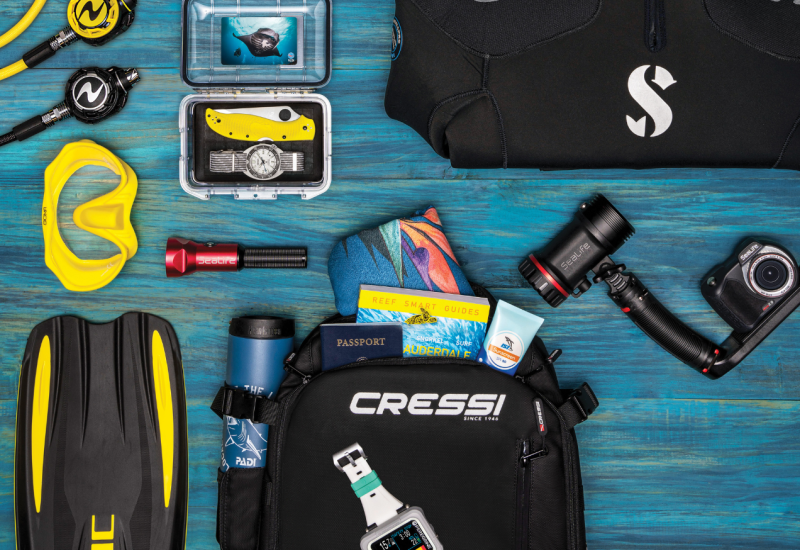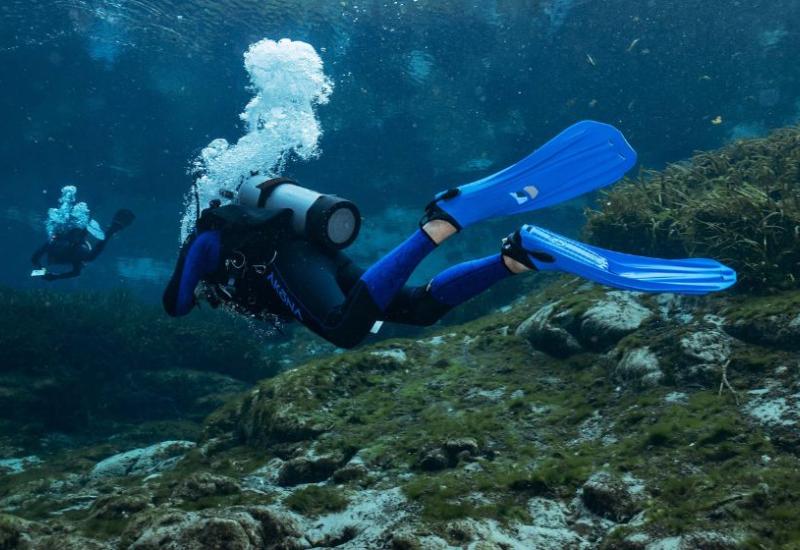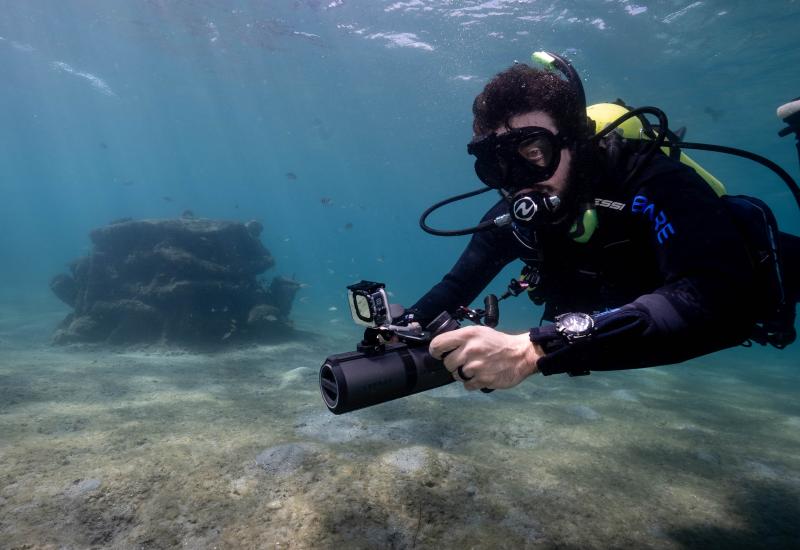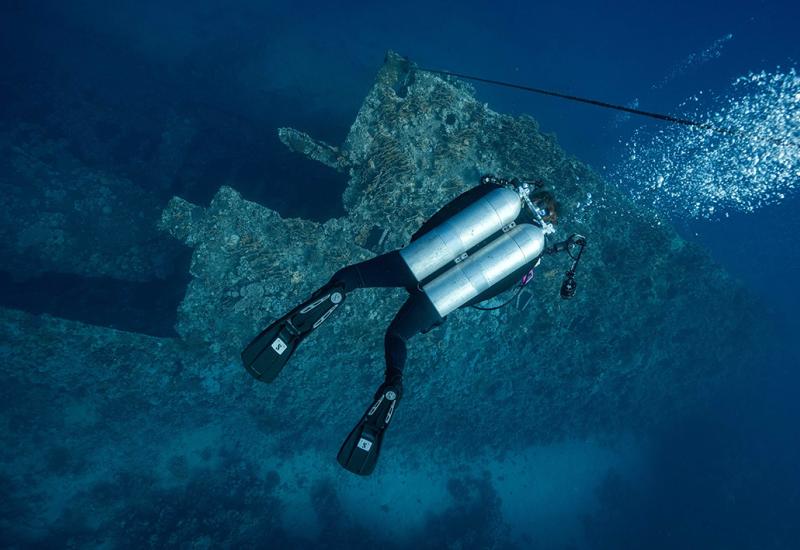Digging Deep on 2009's New Dive Computers
Some of us are just techies by nature. So for all of you who want to delve into the details, here are a few more notes about the dive computers in this year’s tests, and what you should look for when choosing the right one for you.
A Note about Deep Stops
The Deep Stop option has become a much-touted feature on dive computers these days. Theoretically, incorporating deeper deco/safety stops into your ascents contribute to a safer trip back to the surface. However, studies unveiled at the 2008 DAN Tech Diving Conference and the 2008 Decompression and the Deep Stop Workshop, including tests conducted by the Navy’s Experimental Diving Unit (NEDU), indicate that deep stops might not be a benefit after all. In fact, some experts say deep stops might actually increase rather than decrease your chance of DCS. While the debate continues it might not hurt to simply leave the Deep Stop option off, at least until we see more consensus. For more information, contact DAN, dan.org or order the Workshop Proceedings from uhms.org.
Download the Dive Computer Features Chart
Chamber Tests
Liberal vs. Conservative When it comes to dive computers, the terms liberal and conservative refer to how your computer’s algorithm calculates no decompression limits (NDLs). Conservative algorithms limit (sometimes substantially) the amount of time you can spend at depth without putting the computer into deco mode, but increase your safety margin. Liberal algorithms allow much more bottom time before going into deco mode, but by doing so can increase your risk of DCS. The algorithm is your dive computer’s program, a mathematical formula that uses real-time measures of depth, gas mix, time at depth and, in some cases, other data to calculate how long you can safely stay beneath the surface. There are currently a handful of different algorithms being used in dive computers, each using its own proprietary computations, and with its own liberal or conservative leanings. Which one is best? As yet, there is no proven way to make a universal determination. However, we do know that less time spent breathing compressed air at depth means less nitrogen in your system and therefore less potential for DCS. Conservative algorithms calculate shorter NDLS for a given depth and time than more liberal ones. But by doing so they can limit the amount of time you can spend under water, sometimes to the point of aggravation. Bottom line: it’s up to you, the individual diver, to decide which degree of liberalism or conservatism fits your comfort level as a diver. The included graphs are designed to help you do that. These graphs track the no-decompression limits displayed by each computer during our dive profiles. The higher the placement on the chart (indicating more minutes allowed at depth, the more liberal the computer; the lower the placement (indicating fewer minutes allowed at depth), the more conservative the computer. The dive profiles used to create these graphs replicate a typical four-dive day in paradise. They include a 60-minue surface interval between Dive 1 and Dive 2; a 120-minute surface interval/lunch break between Dive 2 and Dive 3, and another 60-minute surface interval between Dive 3 and Dive 4. Adjustable computers were run in their most liberal settings and all were set to air, or 21 percent oxygen. Special Thanks… To Karl Huggins, program manager at the USC Catalina Hyperbaric Chamber, and his staff for their contributions to data collecting and analysis in the making of the Liberal vs. Conservative chart. Download the Chart
Dive Computer PC Kit Review
Download the PC Kit Review Chart For the third phase of dive computer testing, ScubaLab tasked Jeff Lovin (ScubaLab’s lead test diver and designated IT geek) to use and evaluate each computer’s PC download Kit’s hardware and software. His background in the real world is in software design and programming. Note: The Tusa IQ-650 Element is not included in this PC Kit review because it does not offer a PC download feature. The Mares Puck Air is also not included. It does offer an optional PC Kit called Drak for $120. But while the Mares website does have a Version 1.4 available, this software did not support the Puck Air when we tested it; however, this is due to change in the near future.
**
Hollis DG-02**
- PC Kit: Optional, $99.95
- Software Tested: Hollis Computer Interface, Version 2*
Comments: With this download kit the dives are very detailed, almost too much so. This software would appeal to a statistician. There are many screens with all sorts of information. You could spend your entire surface interval going thru it all. At any point of your dive you can see your ascent rate. The dive index includes date, time, computer and location--but not depth or dive time. On the dive profile screen it does not show the dive location—you have to click on a different link to find out. This makes sorting through logs a bit frustrating. The printing features are great; it’s easy to print and read the dive index, plus prints of individual dives are very detailed and include a graph.
**
Oceanic OC1**
- PC Kit: Included with Dive Computer
- Software Tested: Ocean Log, Version 2.2.6 *
Comments: I wasn’t able to get the dive computer to download on my standard laptop, so had to use a different computer. The software provides very detailed dive data with enough different screens to make an info addict swoon. The dive index includes date, time, computer and location, but not depth or dive time. At any point of your dive you can see your ascent rate. The only downside: on the dive profile screen it does not show the dive location, requiring you to click on a different link to get that information. On the other hand, it offers great printing features. Prints of individual dives are detailed and include graph.
SCUBAPRO Galileo Luna
- PC Kit: Included with Dive Computer
- Software: SmartTRAK, Version 2.042
Comments: Our test DC didn’t come with software, requiring that you go to Scubapro’s website to download it—no biggie. The infared transfer is a great concept and when it works, it works great. The software offers lots of options and customizations. It has very nice graphics of the dive profile along with a temperature line. I was impressed with the amount of detail shown, and love the ability to import pictures. Bonus: Mac compatible too.
Sherwood Wisdom 2
- PC Kit: Optional, $80
- Software: Computer Interface, Version 2.0.4
Comments: This dive computer comes with a CD that gives you a link to download software, so you must have internet access to obtain the software. I wasn’t able to download dives off the dive computer. I tried three different laptops and desktops, thought it was a bad cable but that wasn’t the problem. However once the dive data is downloaded you get a very detailed picture of your dives on numerous screens that provide all sorts of information. At any point of your dive you can see your ascent rate. The dive index includes date, time, computer and location, but not depth or dive time. On the dive profile screen it does not show the dive location. You have to click on a different link to find that out, which is frustrating. The printing features are great. Prints of individual dives are detailed and include a graph.
Suunto Cobra 3
- PC Kit: Optional, $98 if purchased separately from DC
- Software Tested: Dive Manager, Version 3
Comments: Our test Cobra 3 came with Version 2.7, but Version 3.0 is available on Suunto’s website for download so I used that instead. Data transfer on this system is very easy and fast. Basically, you start the software on computer, plug the DC into your laptop with included cable and the DC automatically goes into transfer mode—you don’t need to fumble with buttons or menus. Huge plus: the system offers the ability to use different dive computers on different dives and still keep the data as one continuous log book. It’s easy to sort and delete dives you don’t want in your log book (i.e. a short test dive or aborted dive). You can also import your log book from an older Suunto computer, a great selling point for divers who are thinking of upgrading their DC but want to keep their existing electronic log book. Finally, you can select multiple dives and see the dive profile graphs overlay each other, a very useful and cool feature if you want to study your dive profiles for repeat dives on the same location. With this system you can also send your logged dives to DAN.
Suunto Vyper Air
- PC Kit: Optional, $98 if purchased separately
- Software Tested: Dive Manager, Version 3
Comments: This is the same download system as used on the Cobra 3. All comments made on the Cobra 3 software system also apply to the Vyper Air software system.
Zeagle N2ition 3
- PC Kit: Optional, $154.60
- Software Tested: DiveLogBook, Version 1.1
Comments: This is a very simple and bare bones program. It doesn’t come with a CD so you must download the software from Zeagle’s website, which isn’t a big deal. What could be a big deal to some divers is that I couldn’t get the DC to download on any XP computer; rather, I had to use a Vista computer. Once downloaded, I didn’t find a lot of detail in the dive logs. Graphs are small and not very useful if you want to study the profile in great depth. Printouts are very basic and contain very little detailed information. It would be nice to have a choice of which information is shown and which is printed. I also could not print a dive index. *Sherwood, Hollis and Oceanic dive computers use similar software products from a single supplier.
Some of us are just techies by nature. So for all of you who want to delve into the details, here are a few more notes about the dive computers in this year’s tests, and what you should look for when choosing the right one for you.
A Note about Deep Stops
The Deep Stop option has become a much-touted feature on dive computers these days. Theoretically, incorporating deeper deco/safety stops into your ascents contribute to a safer trip back to the surface. However, studies unveiled at the 2008 DAN Tech Diving Conference and the 2008 Decompression and the Deep Stop Workshop, including tests conducted by the Navy’s Experimental Diving Unit (NEDU), indicate that deep stops might not be a benefit after all. In fact, some experts say deep stops might actually increase rather than decrease your chance of DCS. While the debate continues it might not hurt to simply leave the Deep Stop option off, at least until we see more consensus. For more information, contact DAN, dan.org or order the Workshop Proceedings from uhms.org.
Download the Dive Computer Features Chart
Chamber Tests
Liberal vs. Conservative When it comes to dive computers, the terms liberal and conservative refer to how your computer’s algorithm calculates no decompression limits (NDLs). Conservative algorithms limit (sometimes substantially) the amount of time you can spend at depth without putting the computer into deco mode, but increase your safety margin. Liberal algorithms allow much more bottom time before going into deco mode, but by doing so can increase your risk of DCS. The algorithm is your dive computer’s program, a mathematical formula that uses real-time measures of depth, gas mix, time at depth and, in some cases, other data to calculate how long you can safely stay beneath the surface. There are currently a handful of different algorithms being used in dive computers, each using its own proprietary computations, and with its own liberal or conservative leanings. Which one is best? As yet, there is no proven way to make a universal determination. However, we do know that less time spent breathing compressed air at depth means less nitrogen in your system and therefore less potential for DCS. Conservative algorithms calculate shorter NDLS for a given depth and time than more liberal ones. But by doing so they can limit the amount of time you can spend under water, sometimes to the point of aggravation. Bottom line: it’s up to you, the individual diver, to decide which degree of liberalism or conservatism fits your comfort level as a diver. The included graphs are designed to help you do that. These graphs track the no-decompression limits displayed by each computer during our dive profiles. The higher the placement on the chart (indicating more minutes allowed at depth, the more liberal the computer; the lower the placement (indicating fewer minutes allowed at depth), the more conservative the computer. The dive profiles used to create these graphs replicate a typical four-dive day in paradise. They include a 60-minue surface interval between Dive 1 and Dive 2; a 120-minute surface interval/lunch break between Dive 2 and Dive 3, and another 60-minute surface interval between Dive 3 and Dive 4. Adjustable computers were run in their most liberal settings and all were set to air, or 21 percent oxygen. Special Thanks… To Karl Huggins, program manager at the USC Catalina Hyperbaric Chamber, and his staff for their contributions to data collecting and analysis in the making of the Liberal vs. Conservative chart. Download the Chart
Dive Computer PC Kit Review
Download the PC Kit Review Chart For the third phase of dive computer testing, ScubaLab tasked Jeff Lovin (ScubaLab’s lead test diver and designated IT geek) to use and evaluate each computer’s PC download Kit’s hardware and software. His background in the real world is in software design and programming. Note: The Tusa IQ-650 Element is not included in this PC Kit review because it does not offer a PC download feature. The Mares Puck Air is also not included. It does offer an optional PC Kit called Drak for $120. But while the Mares website does have a Version 1.4 available, this software did not support the Puck Air when we tested it; however, this is due to change in the near future.
**
Hollis DG-02**
- PC Kit: Optional, $99.95
- Software Tested: Hollis Computer Interface, Version 2*
Comments: With this download kit the dives are very detailed, almost too much so. This software would appeal to a statistician. There are many screens with all sorts of information. You could spend your entire surface interval going thru it all. At any point of your dive you can see your ascent rate. The dive index includes date, time, computer and location--but not depth or dive time. On the dive profile screen it does not show the dive location—you have to click on a different link to find out. This makes sorting through logs a bit frustrating. The printing features are great; it’s easy to print and read the dive index, plus prints of individual dives are very detailed and include a graph.
**
Oceanic OC1**
- PC Kit: Included with Dive Computer
- Software Tested: Ocean Log, Version 2.2.6 *
Comments: I wasn’t able to get the dive computer to download on my standard laptop, so had to use a different computer. The software provides very detailed dive data with enough different screens to make an info addict swoon. The dive index includes date, time, computer and location, but not depth or dive time. At any point of your dive you can see your ascent rate. The only downside: on the dive profile screen it does not show the dive location, requiring you to click on a different link to get that information. On the other hand, it offers great printing features. Prints of individual dives are detailed and include graph.
SCUBAPRO Galileo Luna
- PC Kit: Included with Dive Computer
- Software: SmartTRAK, Version 2.042
Comments: Our test DC didn’t come with software, requiring that you go to Scubapro’s website to download it—no biggie. The infared transfer is a great concept and when it works, it works great. The software offers lots of options and customizations. It has very nice graphics of the dive profile along with a temperature line. I was impressed with the amount of detail shown, and love the ability to import pictures. Bonus: Mac compatible too.
Sherwood Wisdom 2
- PC Kit: Optional, $80
- Software: Computer Interface, Version 2.0.4
Comments: This dive computer comes with a CD that gives you a link to download software, so you must have internet access to obtain the software. I wasn’t able to download dives off the dive computer. I tried three different laptops and desktops, thought it was a bad cable but that wasn’t the problem. However once the dive data is downloaded you get a very detailed picture of your dives on numerous screens that provide all sorts of information. At any point of your dive you can see your ascent rate. The dive index includes date, time, computer and location, but not depth or dive time. On the dive profile screen it does not show the dive location. You have to click on a different link to find that out, which is frustrating. The printing features are great. Prints of individual dives are detailed and include a graph.
Suunto Cobra 3
- PC Kit: Optional, $98 if purchased separately from DC
- Software Tested: Dive Manager, Version 3
Comments: Our test Cobra 3 came with Version 2.7, but Version 3.0 is available on Suunto’s website for download so I used that instead. Data transfer on this system is very easy and fast. Basically, you start the software on computer, plug the DC into your laptop with included cable and the DC automatically goes into transfer mode—you don’t need to fumble with buttons or menus. Huge plus: the system offers the ability to use different dive computers on different dives and still keep the data as one continuous log book. It’s easy to sort and delete dives you don’t want in your log book (i.e. a short test dive or aborted dive). You can also import your log book from an older Suunto computer, a great selling point for divers who are thinking of upgrading their DC but want to keep their existing electronic log book. Finally, you can select multiple dives and see the dive profile graphs overlay each other, a very useful and cool feature if you want to study your dive profiles for repeat dives on the same location. With this system you can also send your logged dives to DAN.
Suunto Vyper Air
- PC Kit: Optional, $98 if purchased separately
- Software Tested: Dive Manager, Version 3
Comments: This is the same download system as used on the Cobra 3. All comments made on the Cobra 3 software system also apply to the Vyper Air software system.
Zeagle N2ition 3
- PC Kit: Optional, $154.60
- Software Tested: DiveLogBook, Version 1.1
Comments: This is a very simple and bare bones program. It doesn’t come with a CD so you must download the software from Zeagle’s website, which isn’t a big deal. What could be a big deal to some divers is that I couldn’t get the DC to download on any XP computer; rather, I had to use a Vista computer. Once downloaded, I didn’t find a lot of detail in the dive logs. Graphs are small and not very useful if you want to study the profile in great depth. Printouts are very basic and contain very little detailed information. It would be nice to have a choice of which information is shown and which is printed. I also could not print a dive index. *Sherwood, Hollis and Oceanic dive computers use similar software products from a single supplier.










